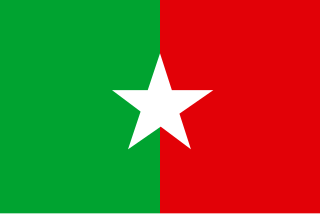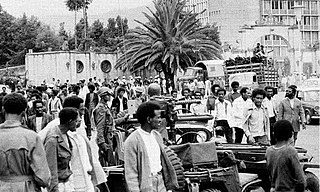
Dawud Ibsaa Ayana (born 1952) is an Ethiopian politician who is the chairman of the Oromo Liberation Front, an Ethiopian political party established in 1973. [1] [2] [3]

Dawud Ibsaa Ayana (born 1952) is an Ethiopian politician who is the chairman of the Oromo Liberation Front, an Ethiopian political party established in 1973. [1] [2] [3]
Ayana attended the Haile Selassie I University in 1970-1971, and participated in the student movement against Haile Selassie. He joined the Association of Oromo University Students.
1974-1976 he participated in the Zemecha campaign. In 1977, Dawud was elected to the OLF Central Committee. From October 1977 to December 1979, he was imprisoned by the Derg.
He returned to University during the 1979-1980 academic year. Dawud fled to Sudan in 1980 and joined an OLF unit operating from that country, before finishing his studies in statistics. He received basic military training in Eritrea a few months later. In April 1981, Dawud commanded the OLF unit that started the armed struggle in Welega Province.
The Derg poisoned Ayana in December 1981, and tortured him for several months. He was jailed without charge at Kerchele Prison during the period of August 1982 to December 1986. Dawud escaped from jail and rejoined the OLF. In 1988 he was re-elected to the OLF Central Committee and Executive Committee, and headed the OLF military department until 1991. In 1998, he was re-elected to the OLF Executive committee and became the group's chairman in 1999. [4] [5] Dawud told Les nouvelles d’Addis on 29 March 2006 that he was confident that the OLF would form the next government in Ethiopia, a speech which motivated many nationalist Oromo diasporas. [5]

The government of Ethiopia is the federal government of Ethiopia. It is structured in a framework of a federal parliamentary republic, whereby the prime minister is the head of government. Executive power is exercised by the government. The prime minister is chosen by the lower chamber of the Federal Parliamentary Assembly. Federal legislative power is vested in both the government and the two chambers of parliament. The judiciary is more or less independent of the executive and the legislature. They are governed under the 1995 Constitution of Ethiopia. There is a bicameral parliament made of the 108-seat House of Federation and the 547-seat House of Peoples' Representatives. The House of Federation has members chosen by the regional councils to serve five-year terms. The House of Peoples' Representatives is elected by direct election, who in turn elect the president for a six-year term.

Mengistu Haile Mariam is an Ethiopian former politician and former army officer who was the head of state of Ethiopia from 1977 to 1991 and General Secretary of the Workers' Party of Ethiopia from 1984 to 1991. He was the chairman of the Derg, the socialist military junta that governed Ethiopia, from 1977 to 1987, and the president of the People's Democratic Republic of Ethiopia (PDRE) from 1987 to 1991.

Brigadier General Tafari Benti was an Ethiopian military officer and politician who served as head of state of Ethiopia from 1974 to 1977 in his role as second chairman of the Derg, the ruling military junta. His official title was Chairman of the Provisional Military Administrative Council.

The Western Somali Liberation Front was a separatist rebel group fighting in eastern Ethiopia to liberate the Ogaden region from Ethiopian control. It played a major role in the Ogaden War of 1977-78 assisting the invading Somali Army.

The Derg, officially the Provisional Military Administrative Council (PMAC), was the Marxist-Leninist military dictatorship that ruled Ethiopia, then including present-day Eritrea, from 1974 to 1987, when the military leadership or junta formally "civilianized" the administration but stayed in power until 1991.

The Ethiopian People's Revolutionary Party (EPRP), informally known as Ihapa, is the first modern political party in Ethiopia. Established in April 1972, it aimed to turn Ethiopia into a democratic republic.

Dembidollo, also spelled Dembi Dolo, is a market town and separate woreda in south-western Ethiopia. It is the capital of Kelam Welega Zone of the Oromia Region. This town, which is at an elevation of between 1,701 m (5,581 ft) and 1,827 m (5,994 ft) above sea level, was originally known as Sayo.

The Oromo Liberation Front is an Oromo nationalist political party formed in 1973 to promote self-determination for the Oromo people inhabiting today's Oromia Region and Oromia Zone in the Amhara Region of Ethiopia. The OLF has offices in Addis Ababa, Washington, D.C. and Berlin from where it operates Amharic and Oromo radio stations.

The Ethiopian Civil War was a civil war in Ethiopia and present-day Eritrea, fought between the Ethiopian military junta known as the Derg and Ethiopian-Eritrean anti-government rebels from 12 September 1974 to 28 May 1991.

The Transitional Government of Ethiopia (TGE) was an era established immediately after the Ethiopian People's Revolutionary Democratic Front (EPRDF) seized power from the Marxist-Leninist People's Democratic Republic of Ethiopia (PDRE) in 1991. During the transitional period, Meles Zenawi served as the president of the TGE while Tamrat Layne was prime minister. Among other major shifts in the country's political institutions, it was under the authority of the TGE that the realignment of provincial boundaries on the basis of ethnolinguistic identity occurred. The TGE was in power until 1995, when it transitioned into the reconstituted Federal Democratic Republic of Ethiopia that remains today.
Echat was a communist organization in Ethiopia. The organization was active between 1975 and 1978. The organization emerged from a split away from the All-Ethiopian Socialist Movement (Meison). Echat was initially allied with the Derg military junta, but later turned against it.
Lencho Letta is an Ethiopian politician and Oromo activist who was founding member of Oromo Liberation Front (OLF). He was the Deputy Secretary General of the Oromo Liberation Front (OLF) from 1974 to 1995. In Late 1990s, Lencho left OLF leadership due to ideological differences. He is currently the leader of Oromo Democratic front, which was formed in 2013.
Baro Tumsa (1938–1978) was a pharmacist, lawyer and Oromo nationalist and political activist in Ethiopia. He was the younger brother of Reverend Gudina Tumsa and mainly responsible for the formation of the Oromo Liberation Front.

The Oromo conflict is a protracted conflict between the Oromo Liberation Front (OLF) and the Ethiopian government. The Oromo Liberation Front formed to fight the Ethiopian Empire to liberate the Oromo people and establish an independent state of Oromia. The conflict began in 1973, when Oromo nationalists established the OLF and its armed wing, the Oromo Liberation Army (OLA). These groups formed in response to prejudice against the Oromo people during the Haile Selassie and Derg era, when their language was banned from public administration, courts, church and schools, and the stereotype of Oromo people as a hindrance to expanding Ethiopian national identity.
Music and politics have been closely intertwined throughout the history of Ethiopia.

The fall of the Derg, also known as Downfall of the Derg, was a military campaign that resulted the defeat of the ruling military junta Derg by the rebel coalition Ethiopian People's Revolutionary Democratic Front (EPRDF) on 28 May 1991 in Addis Ababa, ending the Ethiopian Civil War. The Derg took power after deposing Emperor Haile Selassie and the Solomonic dynasty, an imperial dynasty of Ethiopia that began in 1270. The Derg suffered insurgency with different factions, and separatist rebels groups since early their rule, beginning with the Ethiopian Civil War. The 1983–1985 famine, the Red Terror, and resettlement and villagization infamed the Derg with majority of Ethiopians tended to support insurgent groups like the Tigray People's Liberation Front (TPLF) and Eritrean People's Liberation Front (EPLF).
The 1995 Ethiopian Federal Constitution formalizes an ethnic federalism law aimed at undermining long-standing ethnic imperial rule, reducing ethnic tensions, promoting regional autonomy, and upholding unqualified rights to self-determination and secession in a state with more than 80 different ethnic groups. But the constitution is divisive, both among Ethiopian nationalists who believe it undermines centralized authority and fuels interethnic conflict, and among ethnic federalists who fear that the development of its vague components could lead to authoritarian centralization or even the maintenance of minority ethnic hegemony. Parliamentary elections since 1995 have taken place every five years since enactment. All but one of these have resulted in government by members of the Ethiopian People's Revolutionary Democratic Front (EPRDF) political coalition, under three prime ministers. The EPRDF was under the effective control of the Tigray People's Liberation Front (TPLF), which represents a small ethnic minority. In 2019 the EPRDF, under Abiy, was dissolved and he inaugurated the pan-ethnic Prosperity Party which won the 2021 Ethiopian Election, returning him as prime minister. But both political entities were different kinds of responses to the ongoing tension between constitutional ethnic federalism and the Ethiopian state's authority. Over the same period, and all administrations, a range of major conflicts with ethnic roots have occurred or continued, and the press and availability of information have been controlled. There has also been dramatic economic growth and liberalization, which has itself been attributed to, and used to justify, authoritarian state policy.
This list details about chronological aspect of the Derg, the military junta that ruled Ethiopia from 1974 to 1987 by decade.

On 12 September 1974, Emperor Haile Selassie was deposed by the Coordinating Committee of the Armed Forces, Police, and Territorial Army, a Soviet-backed military junta that consequently ruled Ethiopia as the Derg until 28 May 1991.

Oromo nationalism is an ethnic nationalism advocating the self-interest of Oromo people in Ethiopia and Kenya. Many Oromo elites, intellectuals and political leaders struggled to create an independent Oromia state throughout 19th and 20th century, since the start of Abyssinian colonialism under Emperor Menelik II. No consensus has been reached yet regarding the motives of this type of nationalism, whether the Oromos librate themselves to form a nation-state or offer self-determination in federal Ethiopia.